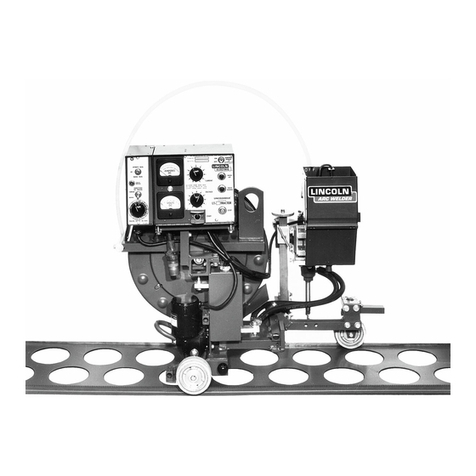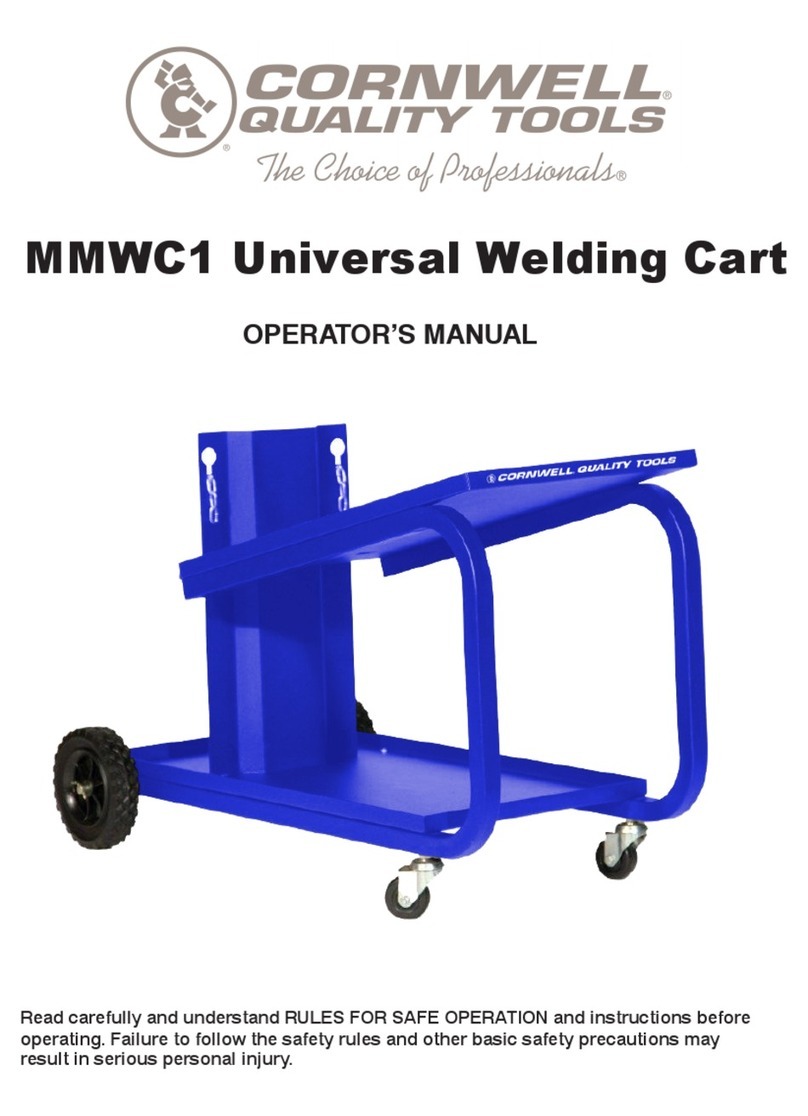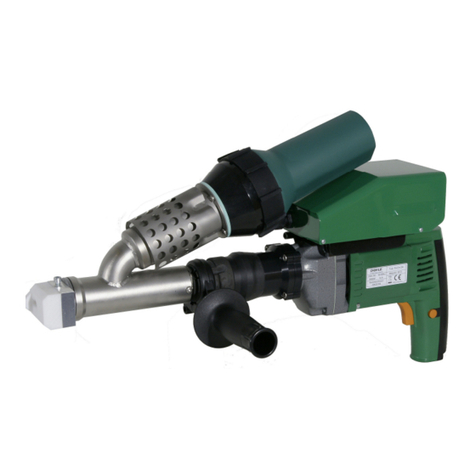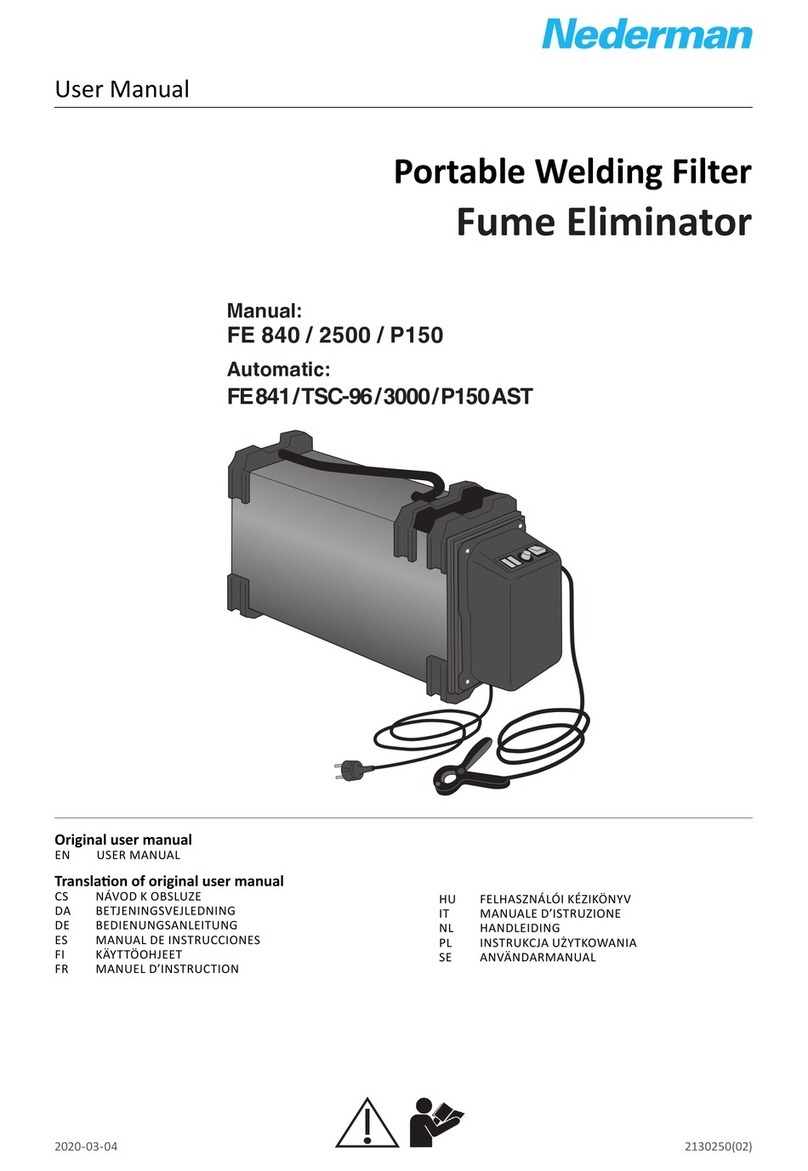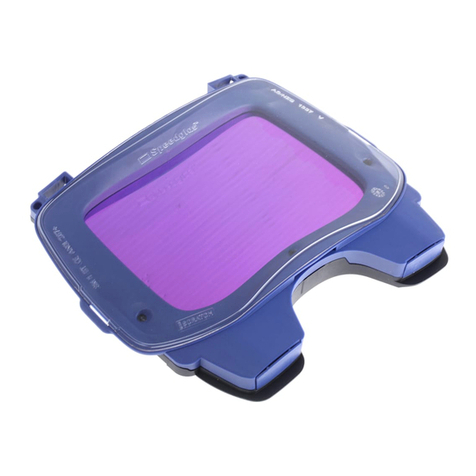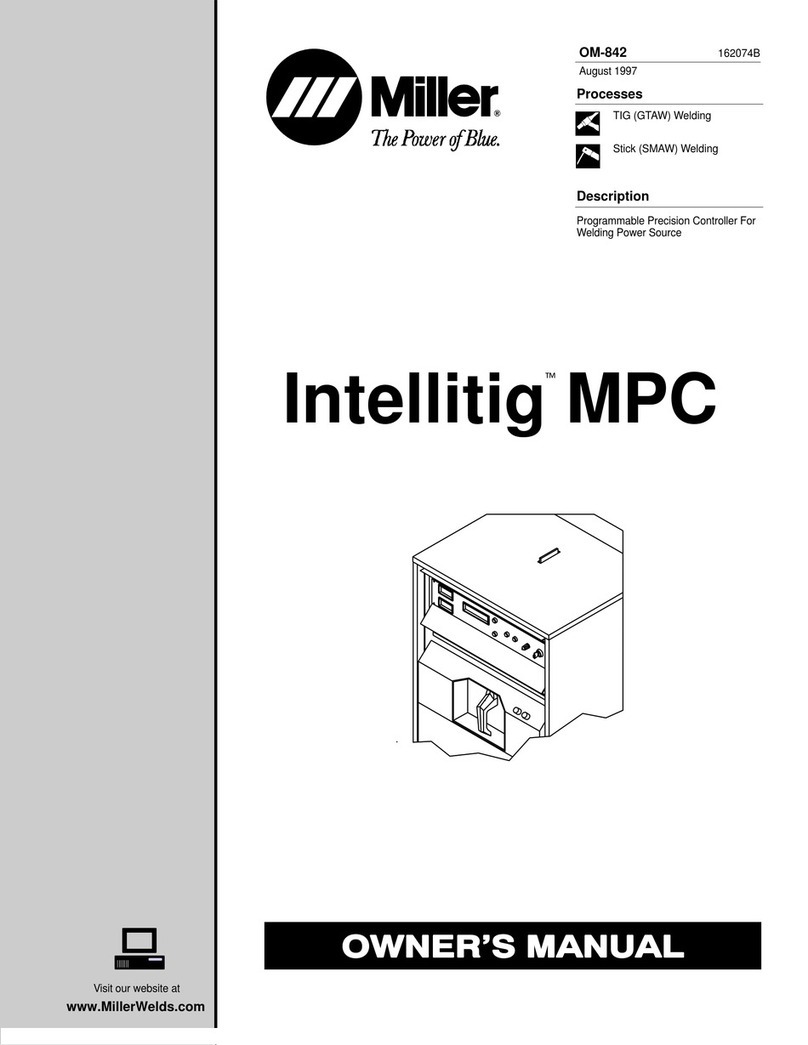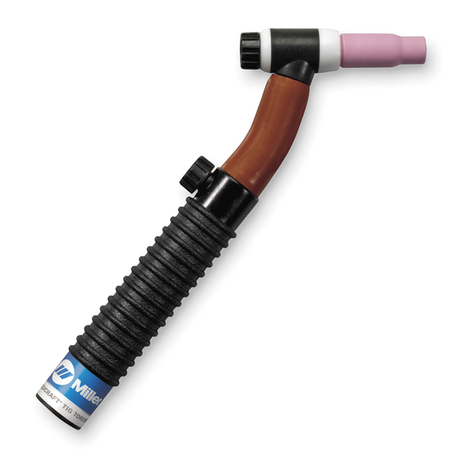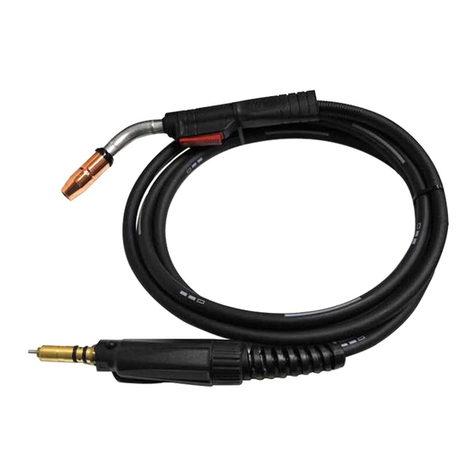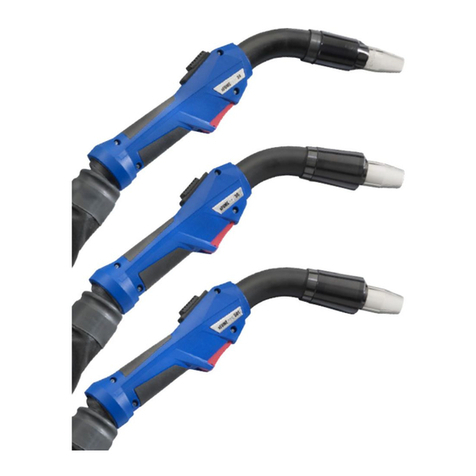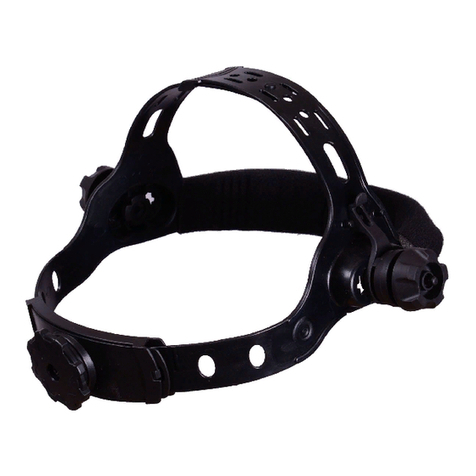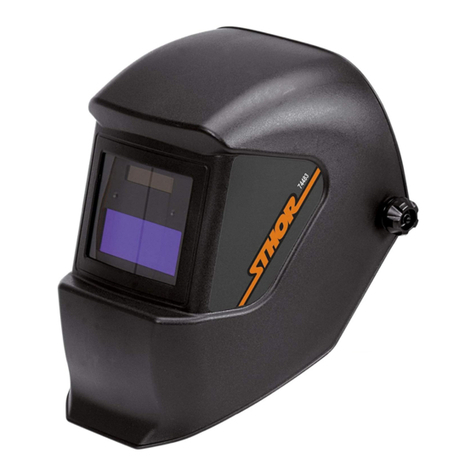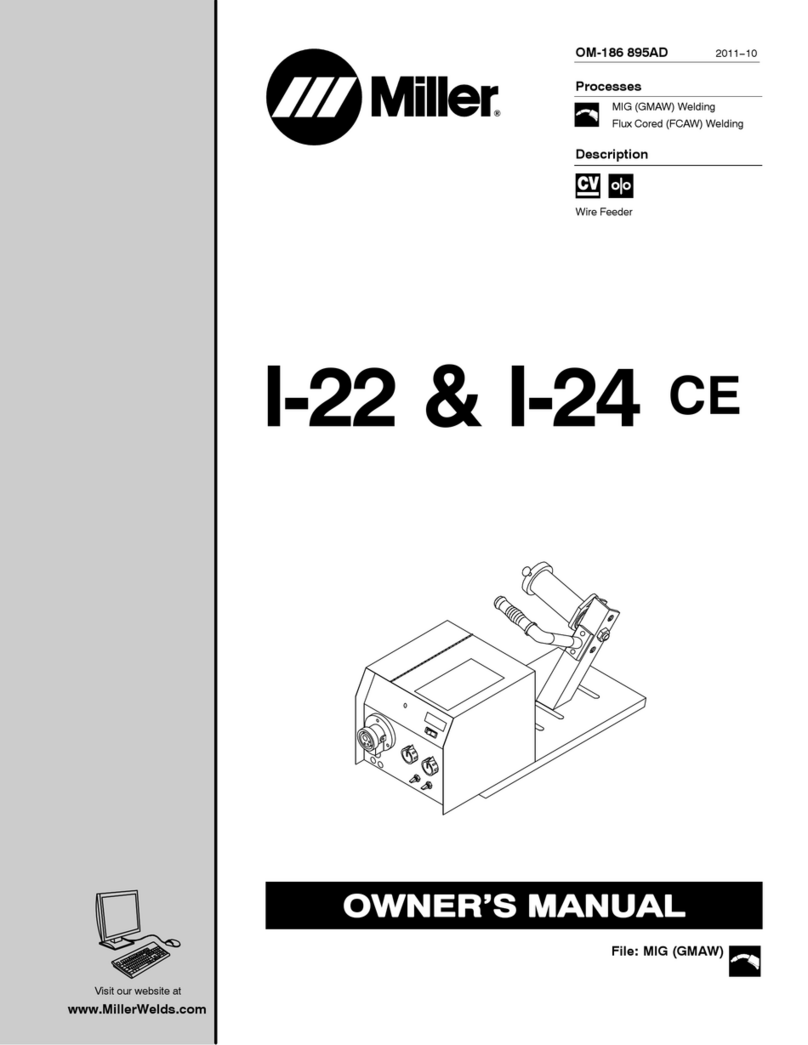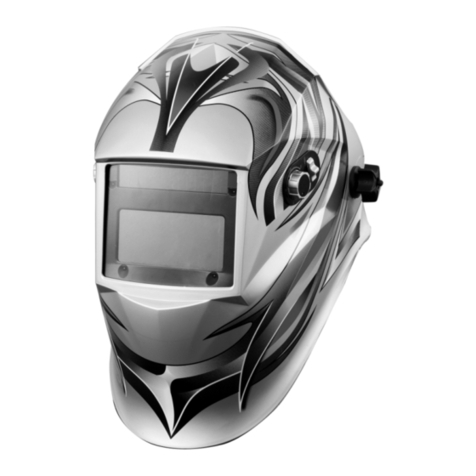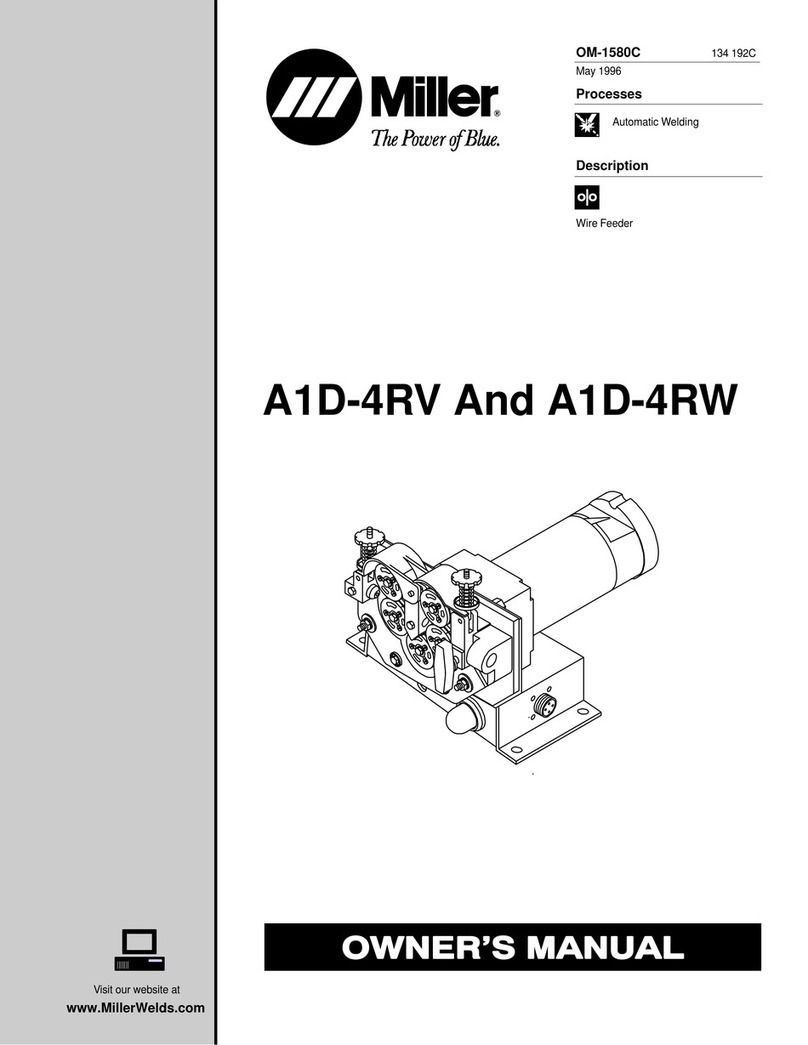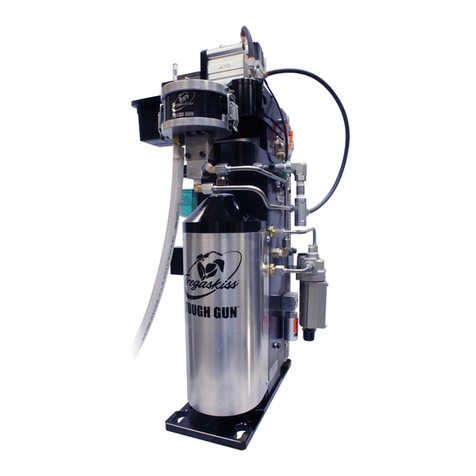voestalpine Bohler Welding MT G 150 Quick guide

1
Firmenname oder Division
www.voestalpine.com
Lasting Connections
MIG MAG
WELDING TORCH
voestalpine Böhler Welding
www.voestalpine.com/welding

3
Fig. 1 - Setting up MT G
Fig. 2 - Setting up MT W
Fig. 3 - Connecting the coolant
1
1
2
2
3
3 4
4
5
1
4
2
3
Functions

10
CONTENTS
1. IDENTIFICATION
2. SAFETY
1. Identification
1.1 Marking
2. Safety
2.1 Safety Instruction
2.2 Designated use
2.3 Classification of the warnings
2.4 Emergency information
3. Product description
3.1 Technical data
3.2 Signs and symbols used
4. Putting into operation
4.1 Setting up the torch
4.2 MT G with pluggable gas nozzle and contact tip holder
4.3 MT W liquid-cooled
4.4 Attaching the wire guide
4.4.1 Liner
4.4.2 PA liner
4.5 Attaching the cable assembly on the machine side
4.6 Connecting the coolant
4.7 Setting the shielding gas volume
4.8 Feeding in the wire
4.9 Torch handle control elements
4.9.1 Trigger function
5. Operation
6. Putting out of operation
7. Maintenance and cleaning
7.1 Replacing the torch neck
8. Disposal
9. Warranty
MIG-MAG manual welding torches are used to safely weld low
and high-alloy materials. They consist of the torch neck with
equipment parts and wear parts, the torch handle and the
cable assembly with a central connection. They conform to EN
60 974-7 and are not considered devices that independently
fulfil functions.
Arc welding can only be carried out in connection with a welding
power source.
1.1. Marking
This product fulfills the requirements that apply to the market
to which it has been introduced. A corresponding marking has
been affixed to the product, if required.
2.1. Safety Instructions
ʸBefore using the system for the first time, please read these
operating instructions carefully.
ʸThese operating instructions provide you with all the infor-
mation you need for trouble-free and safe operation. The
product has been developed and manufactured in ac-
cordance with state-of-the-art methods and the recognized
safety standards and guidelines.
ʸThe operating instructions warn you against unavoidable
residual hazards for user, third parties, devices or other
material property. The safety instructions used, which must
be adhered to, point out construction related unavoidable
residual hazards.
ʸNon-observance of these safety instructions may result in
risks to the life or health of personnel, environmental dama-
ge or material damage. The product may only be operated
in a technically perfect condition in compliance with the
operating instructions.
ʸThe manufacturer will accept no liability for damage caused
by nonobservance of the operating instructions.
ʸUse suitable means to protect yourself and bystanders from
the hazards listed in chapter on safety.
Basic:
ʸBefore carrying out specific work, for example putting into
operation, operation, transport and maintenance, read the
operating instructions carefully and be sure to follow them.
ʸKeep the operating instructions within easy reach at the
device for reference.
ʸEnclose the operating instructions when handing over the
product.
ʸPlease observe the operating instructions of the individual
welding components, such as: Welding power supply and
wire feeding device.
ʸWhen handling gas cylinders, consult the instructions from
the gas manufacturers and the pressurized gas regulations.
ʸPlease observe the accident prevention regulations of the
country in question.
ʸPutting into operation, operating and maintenance work
may only be carried out by qualified personnel. Qualified
personnel are persons who, based on their special training,
knowledge, experience and due to their knowledge of the
relevant standards, are able to assess the tasks assigned to
them and identify possible dangers.
MT G
MT W
Operating instructions - MIG/MAG Torches
DANGER
English
- English -
TRANSLATION OF THE ORIGINAL OPERATING INSTRUCTIONS
The manufacturer reserves the right, at any time and without prior notice, to make such changes and amendments to these
operating instructions as become necessary due to misprints, inaccuracies or product enhancements. Such changes will, however,
be incorporated into subsequent editions of the operating instructions.
All brand names and trademarks that appear in these operating instructions are the property of their respective owners/manu-
facturers.
Our latest product documents as well as all contact details for the voestalpine Böhler Welding national subsidiaries and partners
worldwide can be found on our website at www.voestalpine.com/welding.

11
2.2. Designated use:
ʸThe device described in these instructions may be used only
for the purpose and in the manner described in these inst-
ructions. In doing so, observe the operating, maintenance
and servicing conditions.
ʸAny other use is considered improper.
ʸUnauthorised modifications or changes to enhance the
performance are not permitted.
2.3. Classification of the warnings:
The warnings used in the operating instructions are divided into
four different levels and shown prior to potentially dangerous
work steps. Arranged in descending order of importance, they
have the following meanings:
2.4. Emergency information:
In the event of an emergency, immediately disconnect the
following supplies:
ʸSwitch off the power source
ʸCoolant supply
ʸGas supply
Further measures can be found in the operating instructions
for the power source or the documentation for other peripheral
devices.
Describes an imminent threatening danger. If not avoided, this
will result in fatal or extremely critical injuries.
Describes a potentially dangerous situation. If not avoided, this
may result in serious injuries.
Describes a potentially harmful situation. If not avoided, this
may result in slight or minor injuries.
Describes the risk of impairing work results or potential mate-
rial damage to the equipment.
ʸKeep the work area in order.
ʸEnsure good lighting of the work area.
Electro-technical:
ʸDo not expose electric tools to rain and avoid a moist or wet
environment.
ʸDo not use the electric tools in areas subject to fire or ex-
plosion hazards.
ʸProtect yourself from electric shock by using insulating mats
and wearing dry clothing.
ʸCheck the electric tool for damage and for its perfect func-
tioning in accordance with its designated use.
Welding:
ʸArc welding may cause damage to eyes, skin and hearing!
Please always wear the required safety clothing, eye and
ear protection in compliance with the relevant regulations
in the country in question.
ʸAny metal vapors, especially lead, cadmium, copper and
beryllium are harmful! Ensure sufficient ventilation or ext-
raction. Do not exceed the current MAC values.
ʸRinse work-pieces that have been degreased with chlorina-
ted solvents with clear water. Otherwise there is a risk of
phosgene gas formation. For the same reason, no degrea-
sing baths containing chlorine must be placed in the vicini-
ty of the welding area.
ʸIn connection with various welding torches, there may be
other hazards, for example those caused by: electrical
current (power supply, internal circuit), welding spatter with
regard to combustible or explosive materials, UV radiation
from the arc, smoke and vapors.
ʸAdhere to the general fire protection regulations and remo-
ve inflammable materials from the surroundings of the
welding work area, prior to starting work. Even hours after
finishing the welding work, there is a risk of late ignition
caused by sparks. Place appropriate fire extinguishing
equipment in the workplace within easy reach.
Technical State:
ʸDo not exceed the maximum limit values of the load data.
Overloading leads to torch destruction.
ʸDo not make any constructive changes to this device.
ʸDuring welding work outdoors, use suitable protection against
the effects of weather.
Protective clothing:
ʸDo not wear loose fitting clothing or jewelry.
ʸUse a hair net for long hair.
ʸDuring operation of the welding torches and in connection
with the welding process, always wear safety goggles, pro-
tective gloves and, if required, a breathing mask.
WARNING
CAUTION!
NOTICE
DANGER
English
- English -

12
3. PRODUCT DESCRIPTION
If improperly used, the device can present risks to persons, animals and material property.
ʸUse the device according to its designated use only.
ʸDo not convert or modify the device to enhance its performance without authorisation.
ʸOnly qualified personnel are permitted to perform work on the device or system.
3.1. Technical data
WARNING Hazards caused by improper use!
Transport and storage -25 °C to +55°C
Relative humidity up to 90% at 20°C
Tab. 1 Ambient conditions during operation
Type of voltage DC
DC polarity of the electrodes Usually positive
Shielding gas (DIN EN ISO 14175) CO2and mixed gas M21
Wire types Commercially available round wires
Voltage rating Peak value of 113 V
Protection type of the machine-side connectors (EN 60 529) IP3X
Control device in torch handle For 42 V and 0.1 to 1 A
Tab. 2 General torch data according to EN 60 974-7
Type Type of
cooling
Load DC Wire Ø Gas flow Cooling Flow
pressure
Single
circuit
Standard
light arc
CO2M21 Max. supply
temp.
Min.
flow rate
Min. Max.
AA%mm l/min °C l/min bar bar
MT G serie
150 Air 170 170 60 0.6 - 1.0
250 Air 230 220 60 0.8 - 1.2
300 Air 280 260 60 0.8 - 1.2
350 Air 330 310 60 1.0 - 1.6
MT W serie
440 Liquid 500 450 100 0.8 - 1.6 10 - 20 50 1.5 1.5 3.5
540 Liquid 600 550 100 1.0 - 1.6 10 - 20 50 1.5 1.5 3.5
Tab. 3 Product-specific torch data (EN 60 974-7) MT G and MT W
English
- English -
Standard length L 3.00 m / 4.00 m
Coolant connection Plug-in nipple, nom. diam. 5mm
Cooling unit power Min. 800 W
Control lead 2-wire
Tab. 4 Cable assembly

13
4. PUTTING INTO OPERATION
4.1. Setting up the torch
3.2. Signs and symbols used:
The following signs and symbols are used in the operating instructions:
Symbol Description
ʸBullet symbol for instructions and lists
-> Cross reference symbol refers to detailed, supplementary or further information
1. Step(s) described in the text to be carried out in succession
Risk of injury due to unexpected start-up
The following instructions must be adhered to throughout all
maintenance,servicing, assembly,disassembly and repairwork:
ʸSwitch off the power source.
ʸClose off the gas supply.
ʸClose off the coolant supply.
ʸDisconnect all electrical connections.
Risk of injury and machine damage when handled by
unauthorised persons
Improper repair work and modifications to the product may
lead to serious injuries and damages to the device. The product
warranty will be rendered invalid if the unit is handled by
unauthorised persons.
ʸOnly qualified personnel are permitted to perform work on
the device or system.
DANGER
DANGER
Please take note of the following instructions:
-> 3. PRODUCT DESCRIPTION on page 12
ʸOnly use gas-tight, plastic-insulated wire guides to ensure
a secure shielding gas cover and a defined current contact.
ʸBare liners give rise to a loss of shielding gas.
ʸNew and unused liners must be abridged to the actual length
of the cable assembly.
ʸIf the torch has a fixed torch neck, only through-hole liners
are used.
ʸTo install the wire guide with a little preload, excess length
is required.
NOTICE
NOTICE
NOTICE
Risk of injury
Puncture or cut-in wounds may be caused by the
wire electrode.
ʸKeep your hands out of the danger zone.
ʸWear the correct protective gloves.
CAUTION !
4.2. MT G with pluggable gas nozzle and contact tip holder
Setting up MT G (Fig. 1 / p. 3)
1 - Pluggable gas nozzle
2 - Contact tip
3 - Pluggable contact tip holder
4 - Manifold
4.4. Attaching the wire guide
4.4.1. Liner
MT G/ MT W
For use of steel wires with undivided wire guide.
1. Stretch out the cable assembly and unscrew the gas
nozzle and contact tip from the torch neck.
2. Unscrew the nut from the central connector or direct con-
nector and slide the liner through the cable assembly up
to the retaining nipple.
3. Screw down the nut again, tighten using the provided
wrench and cut off excess length of the liner flush with the
contact tip holder.
4. Mount contact tip and gas nozzle.
English
- English -
4.3. MT W liquid-cooled
Setting up MT W (Fig. 2 / p. 3):
1 - Gas nozzle
2 - Spatter protector (if in place)
3 - Contact tip
4 - Contact tip holder
5 - Torch neck
Set up the torch neck according to the figure (Fig. 2 / p. 3):
1. Screw the replaceable contact tip holder (4) onto the
torch neck (5) and tighten the contact tip holder (4) with
the provided wrench.
2. Screw the contact tip (3) into the contact tip holder (4).
3. Tighten the contact tip (3) with the provided wrench.
If a spatter protector is not yet mounted:
4. Insert the spatter protector (2) into the gas nozzle (1) from
the back.
5. Screw together the gas nozzle (1) and the spatter
protector (2). The spatter protector (2) moves into the
correct position within the gas nozzle (1).

14
ʸEnsure that the coolant supply and return hoses have been
correctly installed. Coolant supply = blue, coolant return =
red.
ʸDo not use deionised or demineralised water as coolant or
for leak and flow tests. This may shorten your welding torch’s
service life.
ʸWe recommend the use of Böhler Welding coolant for liquid-
cooled welding torches.
ʸThe cooling system must be purged of any air each time the
device is commissioned and after every cable assembly
change: disconnect the coolant return hose from the coolant
recirculator and hold it over a collection receptacle. Close
the opening on the coolant return hose. Then re-open it by
abruptly releasing it. Repeat until the coolant flows into the
collection receptacle continuously and without air bubbles.
4.7. Setting the shielding gas volume
ʸThe type and amount of shielding gas used depend on the
welding task and the gas nozzle geometry.
ʸMake all shielding gas connections gas-tight.
ʸTo prevent the shielding gas supply from becoming clogged
by impurities, the cylinder valve must be opened briefly
before connecting the cylinder. This will expel any impuriti-
es that may be present.
ʸEach time the wire is replaced, make sure that the start of
the wire is free of burrs and not bent.
ʸOnly qualified personnel are permitted to perform work on
the device or system.
ʸConsult the documentation for the welding components.
The trigger’s two-cycle mode can be activated when using a
standard welding torch. Further operating modes (e.g. 4-cycle)
and torch handle modules depend on the welding power
source and must be ordered separately.
4.9.1. Trigger function
1. Press and hold the trigger on the handle = start welding.
2. Release the trigger = stop welding.
NOTICE
NOTICE
NOTICE
NOTICE
Risk of injury
Puncture or cut-in wounds may be caused by the wire
electrode.
ʸKeep your hands out of the danger zone.
ʸWear the correct protective gloves.
CAUTION !
4.5. Attaching the cable assembly on the machine side
1. Join the central connector and the central socket at the
wire feeder.
2. Use the connection nut to secure both of these.
3. Attach the coolant supply and return connectors to the
MT W.
4. Attach the shielding gas and control lead connectors in
the case of other machine connections.
4.6. Connecting the coolant
1. Lay the cable assembly connected to the machine side
out straight.
2. Insert the wire into the wire feeder as specified by the
manufacturer.
3. Press the ‘zero-current wire feed’ trigger on the wire
feeder until the wire comes out of the contact tip.
4.9. Torch handle control elements
Risk of burns
The cable assembly overheats if the coolant level is too low.
ʸWear the correct protective gloves.
ʸCheck the coolant level at regular intervals.
Connecting the coolant (Fig. 3 / p. 3)
1 - Control lead
2 - Coolant supply hose
3 - Coolant recirculator
4 - Coolant return hose
WARNING
4.8. Feeding in the wire
English
- English -
For use with aluminium, copper, nickel and stainless steel wires:
1. Lay out cable assembly straight, screw in contact tip.
2. Slide wire guide containing the brass liner first through the
cable assembly until a noticeable resistance is felt at the
contact tip.
3. Slide clamp nipple, O-ring and nut onto PA liner and tigh-
ten the nut under tension.
4. Mark overlength of the PA liner in front of the wire feed
rolls and cut it off at the mark using the cutter.
ʸNew, as yet unused PA liners have to be abridged to the
actual length of the cable assembly.
ʸFor PA liners with an outer diameter of 4.00 mm, the capil-
lary tube in the distance adaptor must be replaced with a
guide tube.
ʸFor changeable and repluggable torch necks and torch
necks that cannot be changed, combined wire guides with
integral brass liner are used.
ʸFor changeable torch necks, a neck-liner made of brass is
used.
NOTICE
4.4.2. PA liner

15
5. OPERATION
6. PUTTING OUT OF OPERATION
7. MAINTENANCE AND CLEANING
8. DISPOSAL
9. WARRANTY
ʸConsult the documentation for the welding components.
ʸAs liquid-cooled cable assemblies start to leak when they
overheat, the coolant recirculator should continue running
for approx. 5 min. after welding.
ʸThe specified maintenance intervals are guidance values
and refer to single-shift operation.
ʸOnly qualified personnel are permitted to perform work on
the device or system.
ʸCheck the coolant hoses, seals and connectors for damage
or leaks and replace if necessary.
ʸCheck and clean the power contact surfaces on the torch
neck and torch neck seat.
ʸCheck and wear your personal protective equipment.
ʸRemove any adhering weld spatter.
ʸEnsure that all threaded fittings are tight.
ʸDo not dispose of the device with household waste.
ʸFor disposal, observe the local regulations, laws, provisions,
standards and guidelines.
7.1 Replacing the torch neck
-> 4.1. SETTING UP THE TORCH on page 13
Scheduled maintenance and cleaning are prerequisites for a
long service life and trouble-free operation.
1. Open the shielding gas cylinder.
2. Switch on the power source.
3. Switch on the coolant recirculator for MT W.
4. Rinse the shielding gas lines.
5. Start the welding process by pressing and holding the
torch trigger.
1. Wait until the shielding gas post-flow time has passed.
2. Close the shut-off-valve for the gas supply.
3. Switch off the power source.
4. Switch off the coolant recirculator.
NOTICE
NOTICE
NOTICE
Risk of injury due to unexpected start-up
The following instructions must be adhered to throughout all
maintenance,servicing, assembly,disassembly and repairwork:
ʸSwitch off the power source.
ʸClose off the gas supply.
ʸClose off the coolant supply.
ʸDisconnect the coolant supply and return hoses.
ʸClose off the compressed air supply.
ʸDisconnect all electrical connections.
Electric shock
Dangerous voltage due to defective cables.
ʸCheck all live cables and connections for proper installation
and damage.
ʸReplace any damaged, deformed or worn parts.
Risk of burns
Risk of burns from hot coolant and hot surfaces.
ʸSwitch off the coolant recirculator before starting mainte-
nance, servicing, assembly, disassembly or repair work.
ʸAllow the welding torches to cool down.
ʸWear the correct protective gloves.
DANGER
DANGER
DANGER
This product is a Böhler Welding product. voestalpine Böhler
Welding GmbH guarantees that the product has been manu-
afactured without defects and offers factory manufacturing
and functional warranty for this procduct upon delivery in line
with current state-of-the-art technology and the current regu-
lations. To the extent that Böhler Welding is responsible for a
deficiency in the product, Böhler Welding shall be obliged to
choose, at its own discretion, to either repair the defect or
deliver a replacement at its own expense. The warranty covers
manufacturing faults, but not damage resulting from natural
wear and tear, overloading or improper use. The warranty
period is defined in the General Terms and Conditions. Excep-
tions in the case of specific products are regulated separately.
Warranty will also be rendered invalid if spare parts and wearing
parts are used that are not Böhler Welding parts and if the
product has been repaired improperly by the user or a third
party. Wearing parts are excluded in general from the warran-
ty. In addition, Böhler Welding is not liable for damage caused
by using our products. Questions about warranty and service
can be addressed to the manufacturer or our distributors. For
more information, www.voestalpine.com/welding
English
- English -

28
voestalpine Böhler Welding
www.voestalpine.com/welding
240/2019/GL
This manual suits for next models
5
Table of contents
Other voestalpine Welding Accessories manuals

voestalpine
voestalpine Bohler Welding Big Vision User manual

voestalpine
voestalpine Bohler Welding Supplied Air User manual

voestalpine
voestalpine Bohler Welding Guardian 50FM Air User manual

voestalpine
voestalpine Bohler EVOLUTION VISION 65F User manual
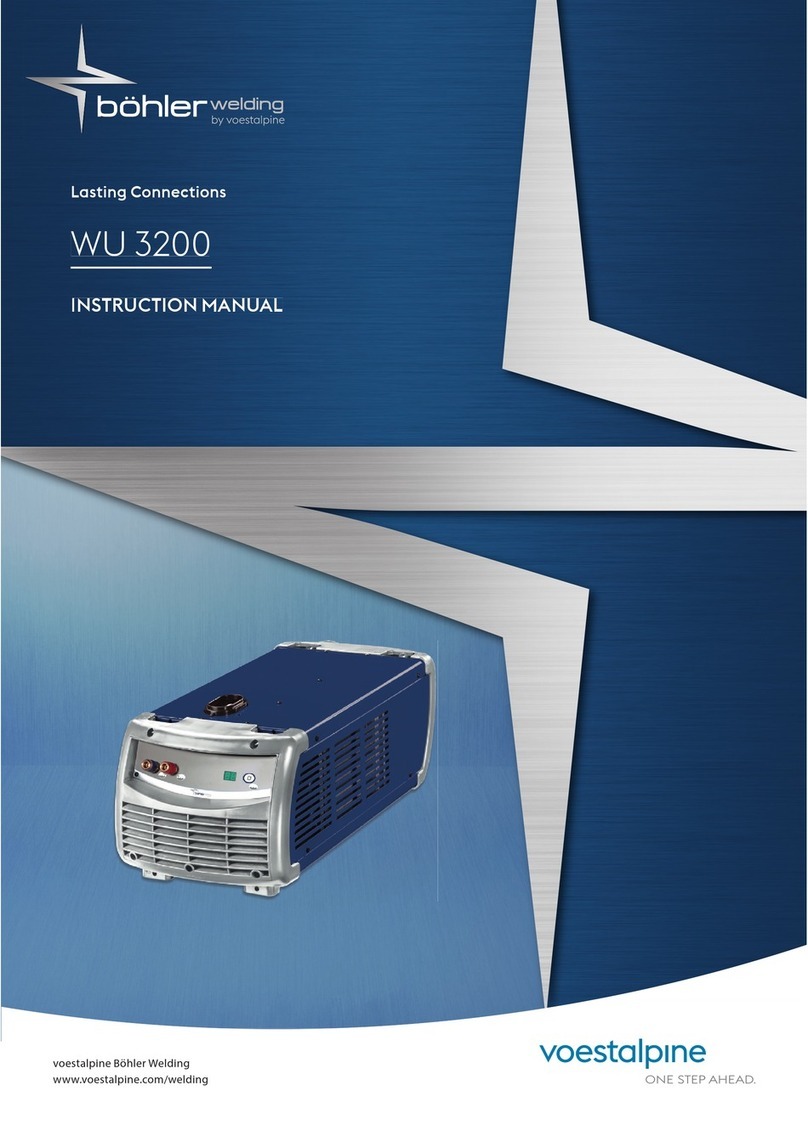
voestalpine
voestalpine Bohler WU 3200 User manual
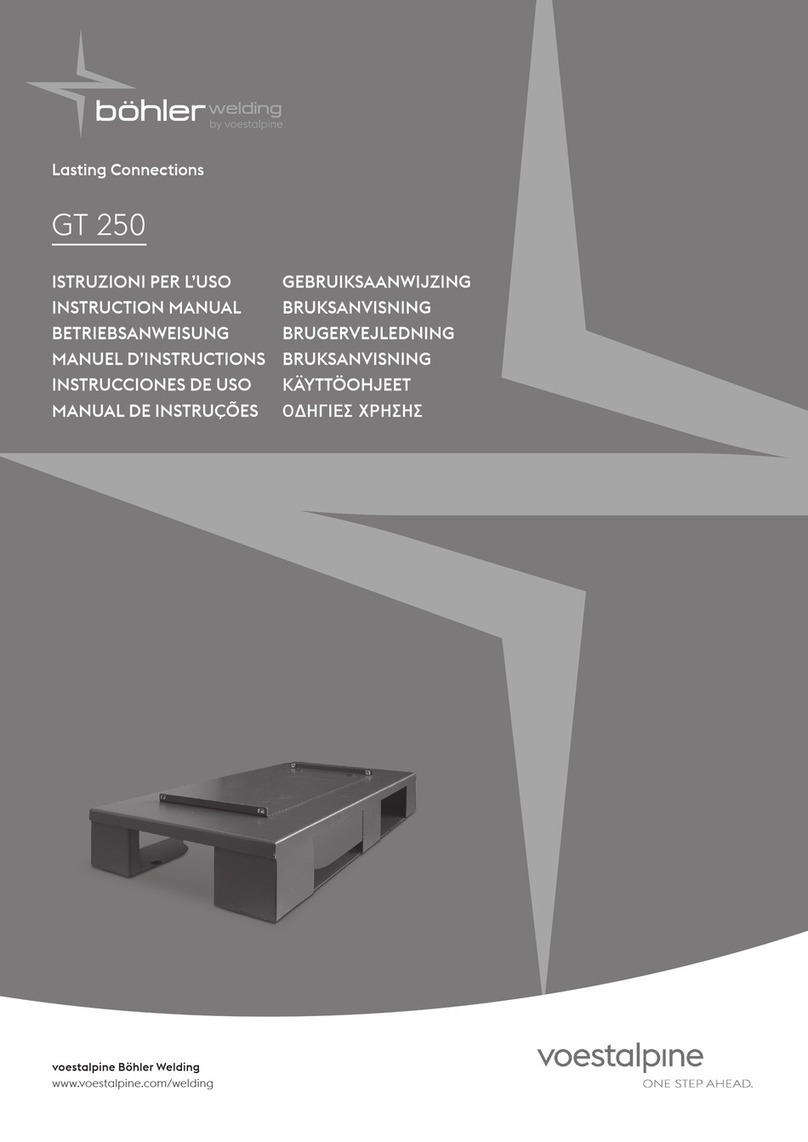
voestalpine
voestalpine Bohler Welding GT 250 User manual

